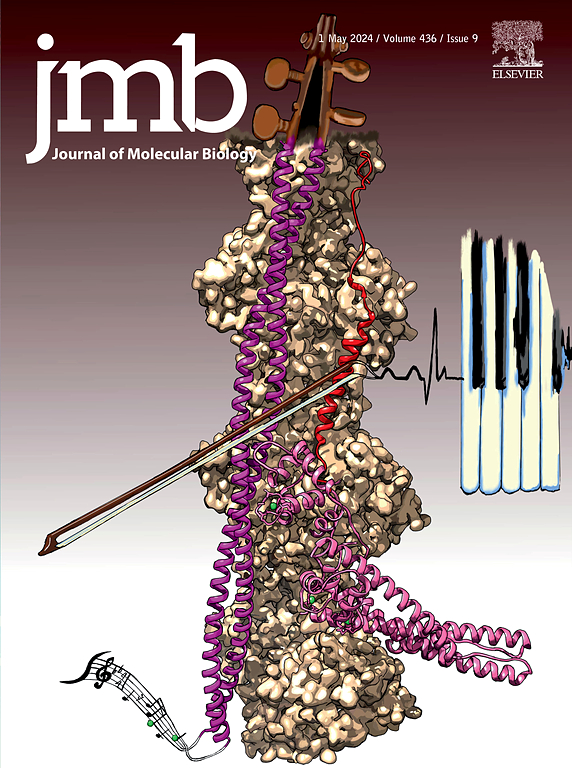Human Rhinovirus B14 with Non-functional Drug-binding Pockets Recovers Infectivity through Stereochemically Constrained Mutations that Restore Capsid Flexibility
IF 4.5
2区 生物学
Q1 BIOCHEMISTRY & MOLECULAR BIOLOGY
引用次数: 0
Abstract
Human rhinovirus (RV) is one of the most frequent human pathogens. As causative agents of most common colds, RVs originate serious socioeconomic problems, and they are also associated to or exacerbate severe respiratory diseases. No anti-rhinoviral drugs or vaccines are available yet. In this study, amino acid residues that delimit a druggable pocket in the RV capsid were individually replaced by larger residues, which in most cases resulted in impaired virus infectivity. After serial infections of human host cells, the hampered mutant viruses invariably recovered full infectivity. Sequencing of the viral progeny revealed that, contrary to what has been observed when deleterious mutations were introduced in other virus capsid regions, those mutant RVs did not regain infectivity through the fixation of second-site mutations. Instead, infectivity was always recovered through reversion or pseudo-reversion events that replaced the deleterious bulky residue with a smaller residue, even though this strategy required, in some cases, the improbable fixation of two nucleotides in the corresponding codon. All-atom molecular dynamics simulations and determination of mechanical elasticity by atomic force microscopy revealed that the small-to-large, deleterious mutations reduced the capsid conformational flexibility; and the large-to-small, infectivity-restoring (pseudo)reversions led to recovery of the capsid flexibility. The stereochemistry of this druggable hydrophobic pocket in RV appears to be biologically constrained: The deleterious effect of reducing pocket volume and capsid flexibility is reverted during virus propagation only through same-site mutations that restore pocket volume and capsid flexibility. These constraints may help the further development of anti-RV drugs.

具有非功能性药物结合口袋的人鼻病毒B14通过立体化学约束突变恢复衣壳灵活性恢复传染性。
人鼻病毒(RV)是最常见的人类病原体之一。作为大多数普通感冒的病原体,病毒引起严重的社会经济问题,它们也与严重的呼吸道疾病有关或加剧。目前还没有抗鼻病毒药物或疫苗可用。在这项研究中,在RV衣壳中划分可药物口袋的氨基酸残基被单独替换为更大的残基,这在大多数情况下导致病毒感染性受损。在连续感染人类宿主细胞后,受到抑制的突变病毒总是完全恢复感染性。病毒后代的测序显示,与在其他病毒衣壳区域引入有害突变时所观察到的相反,这些突变的rv并没有通过固定第二位点突变而重新获得传染性。相反,传染性总是通过还原或伪还原事件恢复,用较小的残基取代有害的大块残基,尽管这种策略在某些情况下需要在相应的密码子上不可能固定两个核苷酸。原子力显微镜下的全原子分子动力学模拟和机械弹性测定表明,由小到大的有害突变降低了衣壳的构象柔韧性;从大到小,感染性恢复(伪)逆转导致衣壳柔韧性的恢复。在RV中,这种可药物化的疏水袋的立体化学似乎受到生物学限制:在病毒传播过程中,减少袋体积和衣壳灵活性的有害影响只有通过恢复袋体积和衣壳灵活性的同位点突变才能恢复。这些限制可能有助于抗rv药物的进一步开发。
本文章由计算机程序翻译,如有差异,请以英文原文为准。
求助全文
约1分钟内获得全文
求助全文
来源期刊

Journal of Molecular Biology
生物-生化与分子生物学
CiteScore
11.30
自引率
1.80%
发文量
412
审稿时长
28 days
期刊介绍:
Journal of Molecular Biology (JMB) provides high quality, comprehensive and broad coverage in all areas of molecular biology. The journal publishes original scientific research papers that provide mechanistic and functional insights and report a significant advance to the field. The journal encourages the submission of multidisciplinary studies that use complementary experimental and computational approaches to address challenging biological questions.
Research areas include but are not limited to: Biomolecular interactions, signaling networks, systems biology; Cell cycle, cell growth, cell differentiation; Cell death, autophagy; Cell signaling and regulation; Chemical biology; Computational biology, in combination with experimental studies; DNA replication, repair, and recombination; Development, regenerative biology, mechanistic and functional studies of stem cells; Epigenetics, chromatin structure and function; Gene expression; Membrane processes, cell surface proteins and cell-cell interactions; Methodological advances, both experimental and theoretical, including databases; Microbiology, virology, and interactions with the host or environment; Microbiota mechanistic and functional studies; Nuclear organization; Post-translational modifications, proteomics; Processing and function of biologically important macromolecules and complexes; Molecular basis of disease; RNA processing, structure and functions of non-coding RNAs, transcription; Sorting, spatiotemporal organization, trafficking; Structural biology; Synthetic biology; Translation, protein folding, chaperones, protein degradation and quality control.
 求助内容:
求助内容: 应助结果提醒方式:
应助结果提醒方式:


